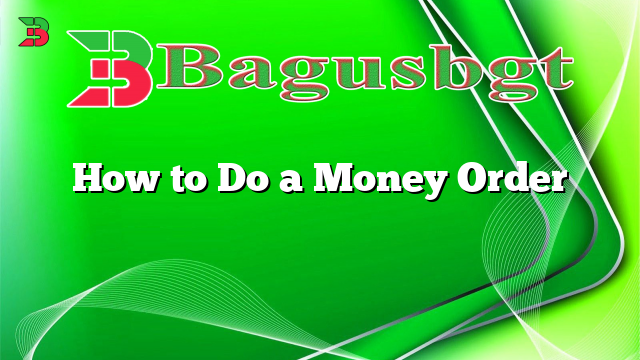Hello and welcome to our guide on how to do a money order. In this article, we will provide you with detailed information on how to complete a money order transaction. Whether you need to pay bills, send money to a friend, or make a purchase, money orders can be a convenient and secure method of payment.
1. Understanding What a Money Order Is
Before we dive into the process of how to do a money order, it’s important to understand what a money order actually is. A money order is a prepaid payment method that is often used as a safe alternative to cash or personal checks. It is a document issued by a financial institution or a postal service that allows the recipient to receive the specified amount of money.
2. Finding a Reliable Provider
The first step in doing a money order is to find a reliable provider. You can obtain money orders from various sources, including banks, credit unions, post offices, and retail stores. Research and compare the fees and services offered by different providers in your area to choose the one that best suits your needs.
3. Gathering the Required Information
Once you have chosen a provider, gather the necessary information for the money order. This typically includes the recipient’s full name, address, and the exact amount you wish to send. Make sure to double-check the spelling and accuracy of the recipient’s information to avoid any issues.
4. Paying for the Money Order
Next, you will need to pay for the money order. The cost of a money order usually includes the face value of the order plus a nominal fee. Some providers may also charge additional fees for certain services, such as international money orders or expedited delivery. Be prepared to pay in cash or, in some cases, with a debit card or traveler’s checks.
5. Filling Out the Money Order
Now it’s time to fill out the money order. Use a pen with blue or black ink and write legibly to ensure the information is clear and readable. Fill in your name and address as the purchaser, and then write the recipient’s name and address in the designated fields. Make sure to double-check all the details before proceeding.
6. Retaining the Receipt
After completing the money order, it is crucial to retain the receipt as proof of purchase. The receipt contains essential information such as the money order number, the amount sent, and the date of the transaction. Keep the receipt in a safe place until you are certain that the money order has been received and cashed.
7. Sending the Money Order
Now that you have filled out the money order and retained the receipt, it’s time to send it to the recipient. If you are mailing the money order, make sure to use a secure envelope and consider sending it via certified mail or with a tracking number for added security. If the money order gets lost or stolen, having a tracking number will help in resolving any issues.
8. Tracking the Money Order
Once the money order has been sent, you may want to track its progress to ensure it reaches the recipient safely. Some money order providers offer online tracking services that allow you to monitor the status of your money order. Keep the receipt handy as it may contain the necessary information required for tracking.
9. Advantages and Disadvantages of Money Orders
Money orders offer several advantages. They are a safe and secure method of payment as they do not contain any personal banking information. Money orders are widely accepted and can be used for various purposes. However, there are also some disadvantages to consider. Money orders often come with fees, which can vary depending on the provider. Additionally, money orders may not be as convenient as other methods of payment, as you need to physically purchase and send them.
10. Alternative Methods of Sending Money
While money orders can be a reliable option, there are alternative methods of sending money that you may consider. Online payment platforms, such as PayPal or Venmo, provide a convenient and instant way to transfer funds to individuals or businesses. These platforms often have lower fees and offer additional features such as buyer protection or the ability to link your bank account for easy transfers.
| Question | Answer |
|---|---|
| Can anyone purchase a money order? | Yes, money orders are available to anyone who needs to make a payment. |
| What is the maximum amount I can send with a money order? | The maximum amount can vary depending on the provider, but it is typically around $1,000. |
| Can I cancel a money order if I made a mistake? | Yes, you can usually cancel a money order if you made a mistake, but there may be a fee involved. |
| Are money orders traceable? | Yes, money orders can be traced using the tracking number or receipt provided at the time of purchase. |
Conclusion
In conclusion, money orders can be a practical and secure way to make payments. By following the steps outlined in this guide, you can easily complete a money order transaction. However, it’s important to consider the advantages and disadvantages of money orders and explore alternative methods of sending money to determine the best option for your specific needs.
 Bagus Banget Collection of the latest information from various reliable sources
Bagus Banget Collection of the latest information from various reliable sources




